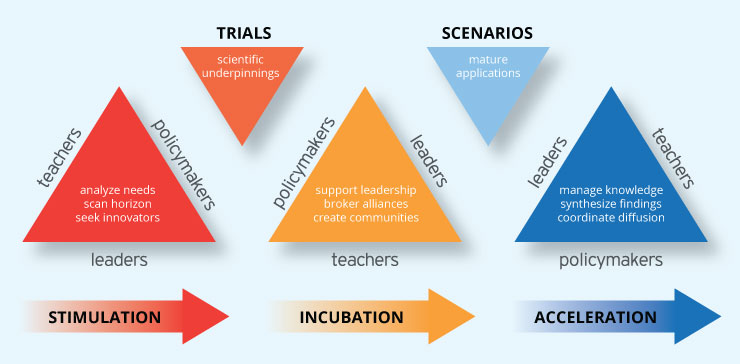|
Three characteristics of ODS illustrate aspects of innovation that are present in the underlying approach. First, there is a strong emphasis on stimulating broad involvement embracing all stakeholders at all levels: local/regional, national and European. Second, there is a hands-on approach to working with actors of change to ensure successful transformation – empowering teachers, school managers, and learners. Third, the approach explicitly supports excellence (centres of expertise and clusters), encourages dissemination of success stories (virtual eLearning communities and information portals), as well as promotes enhanced cooperation and experimentation. Across ODS (and thus, embedded in its model) is the central appreciation for human capacity and the need to share that across all dimensions of work, from the ground up.
At the same time, the formal, externally-based facets of change are crucial to success, particularly for within-country initiation. Classic elements of reform, these include the top-down pressures and incentives that pose powerful levers for change, such as: new assessment policies, new funding mechanisms, and revised curricular frameworks. Because sustainable change requires sound alignment between policy and practice, the connection with external agents (e.g. policymakers) remains an integral part of the ongoing process.

This phase features the awakening of interest and the identification of promising pathways to technology- rich innovation. Needs analysis helps understand stakeholder concerns. Inspiration is sought by scanning the horizon. And innovators that can lead the work (from program champions to team coaches) are identified.
Field trials are undertaken early in the process to (1) engage key stakeholders; as well as (2) to learn important lessons that can inform the rest of the project. Like mini-innovations themselves, field trials participation often prompt creative developments, and are especially helpful for studying localized adaptations.
Incubation refers to the steady, supportive development of new learning, techniques or methods so that sustained development can occur. During this phase, innovation capacity is cultivated so that the change can become self-generative.
Whereas field trials fostered the development and testing of new ideas, scenarios portray the transition from small pilots to stable ways of working under regular teaching and learning circumstances. Scenarios are informed by the experiences to date, and lay the foundation for the final phase of acceleration.
Once technology-rich innovation is up and running in representative settings, attention is turned to issues of sustained maintenance so that they can continue. This includes exploiting the knowledge available within the change setting and establishing routines for continuous quality assessment.
Technology-rich innovation is a term used often, in ODS and elsewhere. This is an umbrella term for teacher and school led change involving any kind of technology. But these days, most people think especially of electronic technologies (e.g. computers, mobile devices) as well as the use of specific applications for learners (e.g. simulations, communication tools) and/or teachers (e.g. electronic access to lessons plans or assessment rubrics). The rationale and goals of technology-rich innovation vary tremendously. The range includes: increasing equitable access to resources for remote schools; fostering Europe’s cultural pluralism; serving the educational needs of all students; and stimulating active learning.
Many people may be involved in technology-rich innovation, and of course each setting is unique. But across most innovations, attention is typically required for at least three core groups of actors: policymakers, teachers and educational leaders. Policy makers are those positioned to activate top-down interaction in some way. This includes (national, state or local) representatives of government, as well as representatives of teacher associations, funding bodies, curriculum agencies and assessment boards. Here, we use the term, teachers, broadly – to represent all educational practitioners who interact directly with pupils. In addition to regular classroom teachers, this includes classroom aids, therapists, remedial teachers, special subject teachers and counsellors. This group is positioned to initiate bottom-up interaction. Educational leaders are those able to lead side-side interaction. This group includes, but is not limited to: headmasters, superintendents, department heads and instructional coaches. Educational leaders play critical roles in implementing policy. They also support the work of teachers both directly (e.g. by ensuring that professional development opportunities are regularly available) and indirectly (e.g. by creating a healthy and stably organization). |





